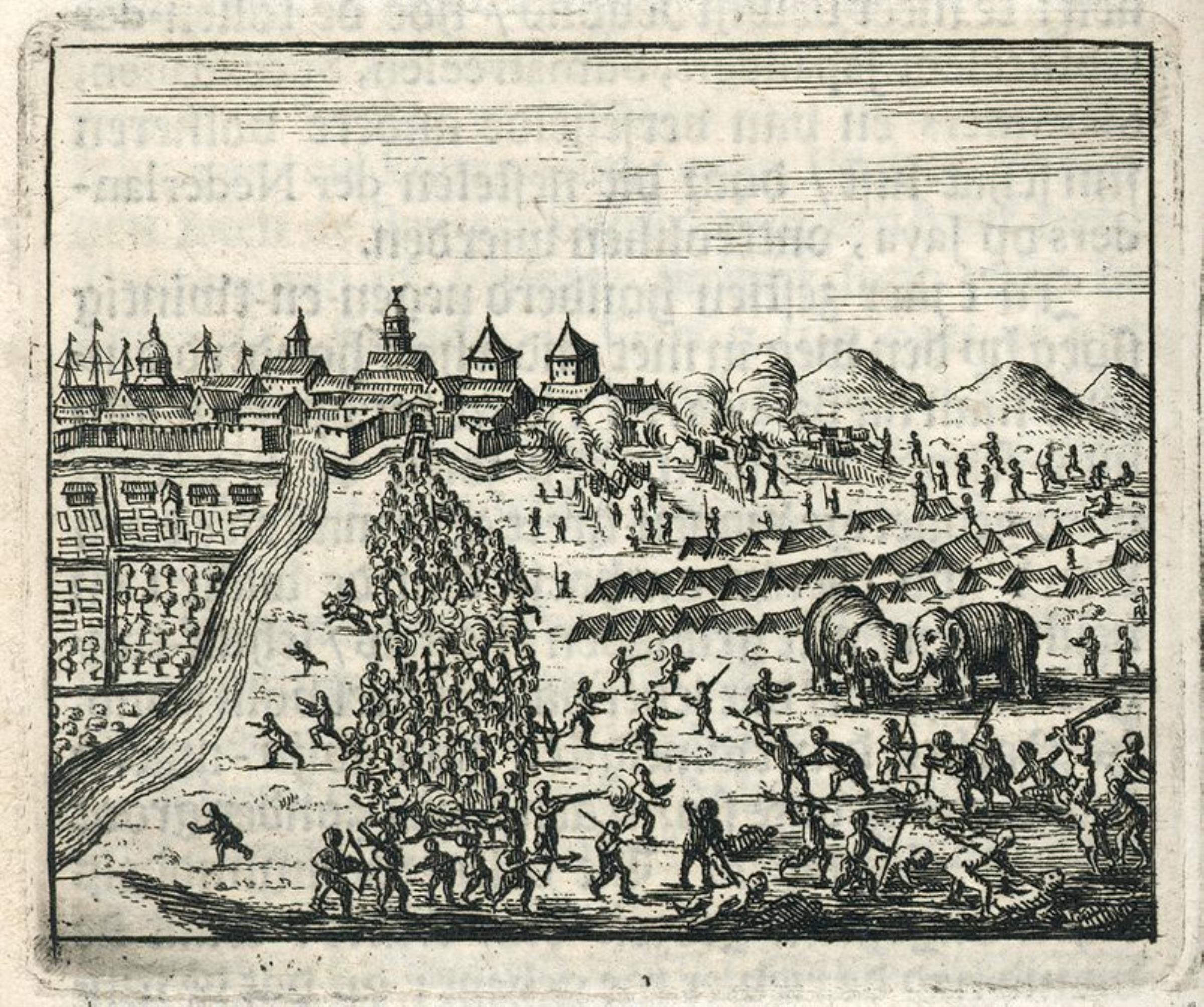|
Malang Regency
Malang Regency (Javanese script, Javanese: ꦏꦧꦸꦥꦠꦼꦤ꧀ꦩꦭꦁ; Pegon script, Pegon: كابوڤاتين مالاڠ; Osob Kiwalan: ''ngalaM'') is the second largest Regency (Indonesia), regency in East Java, Indonesia, with a total area of . It is rich in potential for agriculture, medicinal plants and tourism. It had a population of 2,446,218 people at the 2010 censusBiro Pusat Statistik, Jakarta, 2011. and 2,654,448 at the 2020 Census;Badan Pusat Statistik, Jakarta, 2021. the official estimate as at mid 2023 was 2,711,103.Badan Pusat Statistik, Jakarta, 28 February 2024, ''Kabupaten Malang Dalam Angka 2024'' (Katalog-BPS 1102001.3507) These figures do not include the areas and populations of the two Autonomy, autonomous cities of Malang and Batu (city), Batu which lie geographically within the regency, but are administratively independent. The capital of the regency is the town of Kepanjen. Most of the population resides in the Greater Malang (''Malang Raya'') area ... [...More Info...] [...Related Items...] OR: [Wikipedia] [Google] [Baidu] |
List Of Regencies And Cities Of Indonesia
Regency (Indonesia), Regencies () and City status in Indonesia#Kota, cities (''kota'') are the second-level subdivisions of Indonesia, administrative subdivision in Indonesia, immediately below the Provinces of Indonesia, provinces, and above the Districts of Indonesia, districts. Regencies are roughly equivalent to American County (United States), counties, although Lists of populated places in the United States, most cities in the United States are below the counties. Following the implementation of decentralization beginning on 1 January 2001, regencies and city municipalities became the key administrative units responsible for providing most governmental services. Each of regencies and cities has their own local government and legislative body. The difference between a regency and a city lies in demography, size, and economy. Generally, a regency comprises a rural area larger than a city, but also often includes various towns. A city usually has non-agricultural economic acti ... [...More Info...] [...Related Items...] OR: [Wikipedia] [Google] [Baidu] |
Greater Malang
Greater Malang () is a region in East Java, Indonesia, encompassing the municipality of Malang and its hinterland. About 3 million people in East Java reside in Greater Malang. The principal city, Malang is well known as the home of notable universities in Indonesia, and the nearby Batu (now also an independent city), is well known as a tourism centre in East Java. History ''Karesidenan Malang'' In the Dutch colonial era, Greater Malang was a residency, an old form of second-tier subdivision, called ''Karesidenan Malang'' (Malang Residency)'','' consisting of four cities (Malang, Batu, Pasuruan, Probolinggo) and four regencies (Malang Regency, Pasuruan Regency, Probolinggo Regency, Lumajang Regency). But now, the definition of Greater Malang just consists of the Malang highlands area, namely Malang city, Batu city, and Malang Regency, together with one district (''kecamatan'' Purwodadi) of Pasuruan Regency. Even this is excessive, as parts of Malang Regency - the 9 dis ... [...More Info...] [...Related Items...] OR: [Wikipedia] [Google] [Baidu] |
Districts Of Indonesia
In Indonesia, district or ambiguously subdistrict, is the third-level Subdivisions of Indonesia, administrative subdivision, below Regency (Indonesia), regency or City status in Indonesia, city. The local term is used in the majority of Indonesian areas. The term is used in Western New Guinea, provinces in Papua. In the Special Region of Yogyakarta, the term ''kapanewon'' is used for districts within the regencies, while the term ' is used for districts within Yogyakarta, the province's only city. According to Statistics Indonesia, there are a total of 7,288 districts in Indonesia as of 2023, subdivided into 83,971 administrative villages (rural ' and urban '). During the Dutch East Indies and early republic period, the term ''district'' referred to ''kewedanan'', a subdivision of regency, while ' was translated as ''subdistrict'' (). Following the abolition of ''kewedanan'', the term ''district'' began to be associated with ' which has since been directly administered by regency ... [...More Info...] [...Related Items...] OR: [Wikipedia] [Google] [Baidu] |
Trunojoyo
Trunajaya (Madurese) or Tronajâyâ, also known as Panembahan Maduretno (1649 – 2 January 1680), was a prince and warlord from Arosbaya, Bangkalan, Madura, known for leading the Trunajaya rebellion (1674–1681) against the rulers of the Mataram Sultanate on the island of Java. Rebellion Trunajaya was born in Madura. In 1674 he led a revolt against Amangkurat I and Amangkurat II of Mataram. He was supported by itinerant fighters from Makassar led by Karaeng Galesong. The Trunajaya rebellion moved swiftly, gained momentum, and captured the Mataram court at Plered in mid-1677. The Mataram king, Amangkurat I, escaped to the north coast with his eldest son, the future king Amangkurat II, leaving his younger son ''Pangeran'' (Prince) Puger in Mataram. More interested in profit and revenge than in running a struggling empire, the rebel Trunajaya looted the court and withdrew to his stronghold in Kediri, East Java, leaving Prince Puger in control of a weak court. While on hi ... [...More Info...] [...Related Items...] OR: [Wikipedia] [Google] [Baidu] |
Dutch East India Company
The United East India Company ( ; VOC ), commonly known as the Dutch East India Company, was a chartered company, chartered trading company and one of the first joint-stock companies in the world. Established on 20 March 1602 by the States General of the Netherlands amalgamating Voorcompagnie, existing companies, it was granted a 21-year monopoly to carry out trade activities in Asia. Shares in the company could be purchased by any citizen of the Dutch Republic and subsequently bought and sold in open-air secondary markets (one of which became the Amsterdam Stock Exchange). The company possessed quasi-governmental powers, including the ability to wage war, imprison and execute convicts, negotiate treaties, strike Coinage of the Dutch East India Company, its own coins, and establish colonies. Also, because it traded across multiple colonies and countries from both the East and the West, the VOC is sometimes considered to have been the world's first multinational corporation. St ... [...More Info...] [...Related Items...] OR: [Wikipedia] [Google] [Baidu] |
Wali Songo
''Wali Songo'' (), also transcribed as ''Wali Sanga'', are revered saints of Islam in Indonesia, especially on the island of Java, because of their historic role in the spread of Islam in Indonesia. The word ''wali'' is Arabic for "trusted one" or "friend of God" ("saint" in this context), while the word ''sanga'' is Javanese for the number nine. Although referred to as a group, there is good evidence that fewer than nine were alive at any given time. Also, some sources use the term "Wali Sanga" to refer to saintly mystic(s) other than the most well-known nine individuals. Each man is often attributed the title '' sunan'' in Javanese, which may derive from ''suhun'', in this context meaning "honoured". Most of the wali were also called ''raden'' during their lifetimes, because they were members of royal houses. The graves of the Wali Sanga are venerated as locations of ziarah ( ziyarat) or local pilgrimage in Java. The graves are also known as ''pundhen'' in Javanese. Origi ... [...More Info...] [...Related Items...] OR: [Wikipedia] [Google] [Baidu] |
Demak, Demak
Demak is a town and an administrative district (''kecamatan'') in Central Java Province of Indonesia. It is the capital of Demak Regency and was the location of the former Sultanate of Demak, the first Muslim state on Java and briefly the strongest power on the island of Java in the early 16th century. The district covers an area of 61.13 km2, and had a population of 110,165 at the 2020 Census;Badan Pusat Statistik, Jakarta, 2021. the official estimate as at mid 2023 was 115,115 - comprising 57,699 males and 57,416 females.Badan Pusat Statistik, Jakarta, 26 September 2024, Kecamatan Demak Dalam Angka 2024 (Katalog-BPS 1102001.3321070). Administrative Villages Demak District is divided into the following nineteen towns and villages (six of which have the status of urban ''kelurahan'' - indicated by an asterisk after their name in the following table - and thirteen with the status of rural ''desa''), tabulated below with their areas and their populations according to the mid-2023 of ... [...More Info...] [...Related Items...] OR: [Wikipedia] [Google] [Baidu] |
Majapahit
Majapahit (; (eastern and central dialect) or (western dialect)), also known as Wilwatikta (; ), was a Javanese people, Javanese Hinduism, Hindu-Buddhism, Buddhist thalassocracy, thalassocratic empire in Southeast Asia based on the island of Java (in modern-day Indonesia). At its greatest extent, following significant military expansions, the territory of the empire and its tributary states covered almost the entire Nusantara (term), Nusantara archipelago, spanning both Asia and Oceania. After a Regreg war, civil war that weakened control over the vassal states, the empire slowly declined before collapsing in 1527 due to an Demak–Majapahit conflicts, invasion by the Demak Sultanate, Sultanate of Demak. The fall of Majapahit saw the rise of History of Indonesia#Islamic civilizations, Islamic kingdoms in Java. Established by Raden Wijaya in 1292, Majapahit rose to power after the Mongol invasion of Java and reached its peak during the era of the queen Tribhuwana Wijayatungga ... [...More Info...] [...Related Items...] OR: [Wikipedia] [Google] [Baidu] |
Mataram Sultanate
The Sultanate of Mataram () was the last major independent Javanese people, Javanese kingdom on the island of Java (island), Java before it was Dutch Empire, colonised by the Dutch. It was the dominant political force radiating from the interior of Central Java from the late 16th century until the beginning of the 18th century. Mataram reached its peak of power during the reign of Sultan Agung of Mataram, Sultan Agung Anyokrokusumo (), and began to decline after his death in 1645. By the mid-18th century, Mataram lost both power and territory to the Dutch East India Company (Dutch: ''Vereenigde Oost-Indische Compagnie''; ''VOC''). It had become a vassal state of the company by 1749. Etymology The name ''Mataram'' itself was never the official name of any polity, as the Javanese often refer to their realm simply as ''Bhumi Jawa'' or ''Tanah Jawi'' (). ''Mataram'' refers to the historical areas of plains south of Mount Merapi around present-day Muntilan, Sleman Regency, Sleman ... [...More Info...] [...Related Items...] OR: [Wikipedia] [Google] [Baidu] |
Tumapel
Tumapel was the capital city of Singhasari (1222 - 1292) near the modern city of Malang. Prior to Singhasari, it was under Kediri Kingdom Kediri Kingdom or Kadiri, also known as Panjalu, was a Hindu-Buddhist Javanese people, Javanese kingdom based in East Java from 1042 until 1222 (1292–1293 under Jayakatwang). This kingdom is centered in the ancient city ''Dahanapura'', des .... References {{coord missing, Indonesia Singhasari ... [...More Info...] [...Related Items...] OR: [Wikipedia] [Google] [Baidu] |
Singhasari
Singhasari ( or , ), also known as Tumapel, was a Javanese people, Javanese Hindu-Buddist empires, Hindu-Buddhist Monarchy, kingdom located in east Java (island), Java between 1222 and 1292. The kingdom succeeded the Kingdom of Kediri as the dominant kingdom in eastern Java. The kingdom's name is cognate to the Singosari district of Malang Regency, located several kilometres north of Malang City. Etymology Singhasari (alternate spelling: ''Singosari'') was mentioned in several Javanese manuscripts, including Pararaton. According to tradition, the name was given by Ken Arok during the foundation of the new kingdom to replace its old name, Tumapel, located in a fertile highland valley which today corresponds to the area in and around Malang city. It derives from Sanskrit word ''singha'' which means "lion" and ''sari'' which in Old Javanese could mean either "essence" or "to sleep". Thus Singhasari could be translated as "essence of lion" or "sleeping lion". Although the asiati ... [...More Info...] [...Related Items...] OR: [Wikipedia] [Google] [Baidu] |


